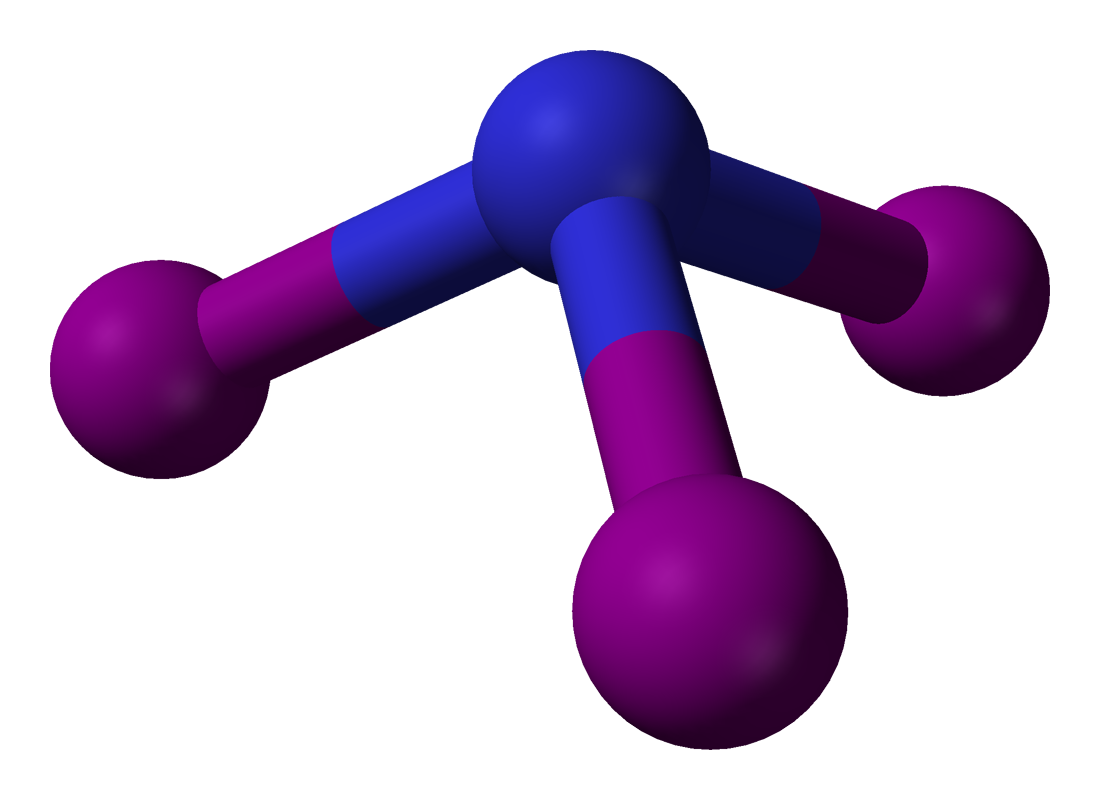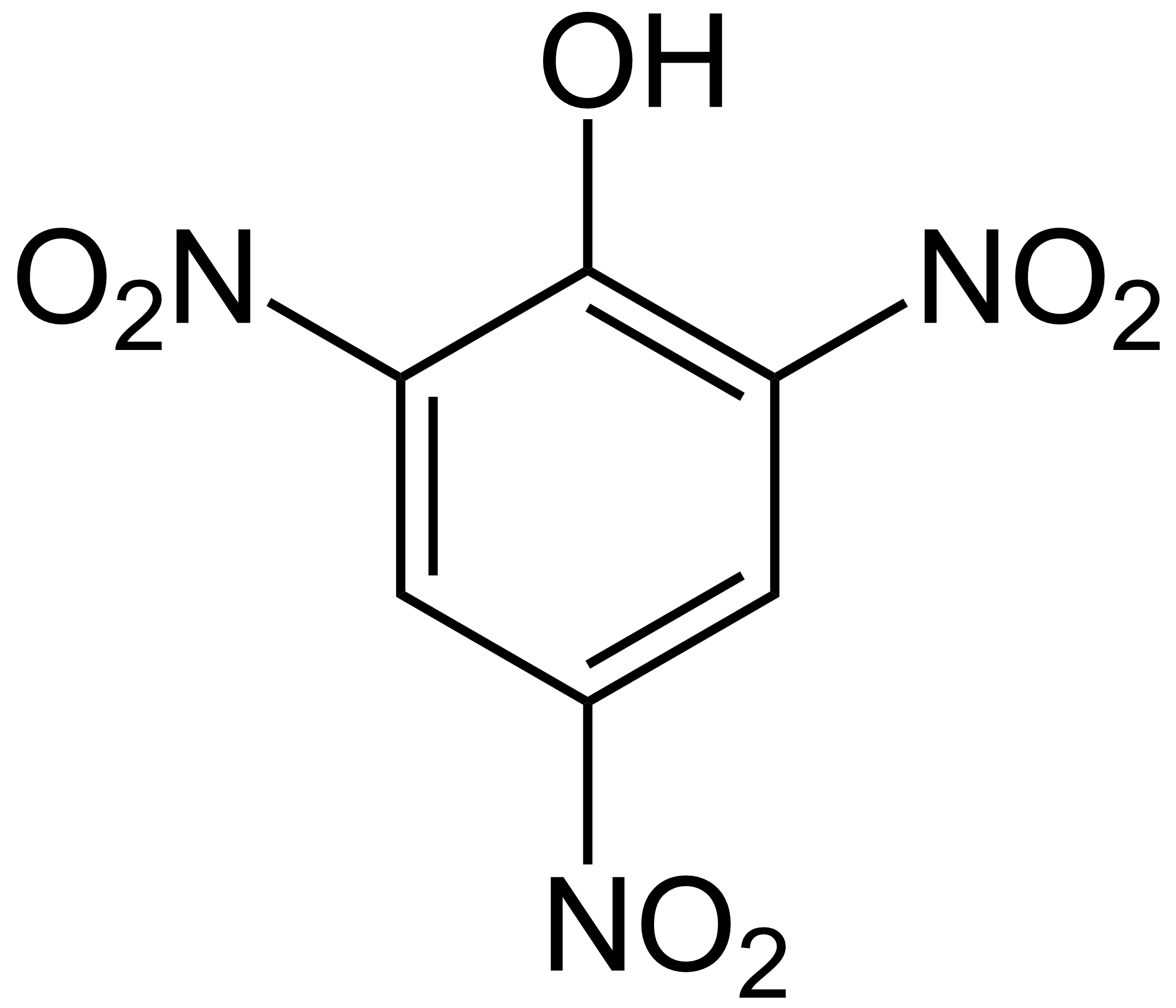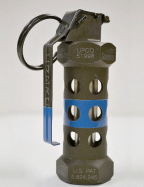Contact explosive on:
[Wikipedia]
[Google]
[Amazon]
A contact explosive is a
 The structures and bonds that make up a contact explosive contribute to its instability. Covalent compounds that have a large unequal sharing of electrons have the capability to fall apart very easily and explosively. Nitrogen triiodide is a perfect example of this property. The three huge iodine atoms try to attach themselves to one small nitrogen ion, which means that the atoms are holding on to each other through a very weak bond. The weak bond between each atom is like a thread just waiting to break. Therefore, any small amount of applied energy cuts this thread and releases the iodine and nitrogen atoms to react with the fuel, allowing the reaction to occur quickly and release a large amount of energy.
The shape of the contact explosive molecule plays a role in its instability as well. Using nitrogen triiodide as an example again, its pyramidal shape forces the three iodine atoms to be incredibly close to each other. The shape further strains the already weak bonds that holds together this molecule.
The structures and bonds that make up a contact explosive contribute to its instability. Covalent compounds that have a large unequal sharing of electrons have the capability to fall apart very easily and explosively. Nitrogen triiodide is a perfect example of this property. The three huge iodine atoms try to attach themselves to one small nitrogen ion, which means that the atoms are holding on to each other through a very weak bond. The weak bond between each atom is like a thread just waiting to break. Therefore, any small amount of applied energy cuts this thread and releases the iodine and nitrogen atoms to react with the fuel, allowing the reaction to occur quickly and release a large amount of energy.
The shape of the contact explosive molecule plays a role in its instability as well. Using nitrogen triiodide as an example again, its pyramidal shape forces the three iodine atoms to be incredibly close to each other. The shape further strains the already weak bonds that holds together this molecule.
 Militaries use a variety of contact explosives in combat. Some can be manufactured into different types of bombs, tactical grenades, and even explosive bullets. Dry picric acid, which is more powerful than TNT, was used in blasting charges and artillery shells. A lot of contact explosives are used in detonators. For explosives that use
Militaries use a variety of contact explosives in combat. Some can be manufactured into different types of bombs, tactical grenades, and even explosive bullets. Dry picric acid, which is more powerful than TNT, was used in blasting charges and artillery shells. A lot of contact explosives are used in detonators. For explosives that use  Flash powders are used in a variety of military and police tactical pyrotechnics.
Flash powders are used in a variety of military and police tactical pyrotechnics.
List of shock-sensitive materials
Explosives
chemical substance
A chemical substance is a form of matter having constant chemical composition and characteristic properties. Some references add that chemical substance cannot be separated into its constituent elements by physical separation methods, i.e., wi ...
that explode
An explosion is a rapid expansion in volume associated with an extreme outward release of energy, usually with the generation of high temperatures and release of high-pressure gases. Supersonic explosions created by high explosives are known ...
s violently when it is exposed to a relatively small amount of energy
In physics, energy (from Ancient Greek: ἐνέργεια, ''enérgeia'', “activity”) is the quantitative property that is transferred to a body or to a physical system, recognizable in the performance of work and in the form of heat a ...
(e.g. friction
Friction is the force resisting the relative motion of solid surfaces, fluid layers, and material elements sliding against each other. There are several types of friction:
*Dry friction is a force that opposes the relative lateral motion of t ...
, pressure
Pressure (symbol: ''p'' or ''P'') is the force applied perpendicular to the surface of an object per unit area over which that force is distributed. Gauge pressure (also spelled ''gage'' pressure)The preferred spelling varies by country and e ...
, sound
In physics, sound is a vibration that propagates as an acoustic wave, through a transmission medium such as a gas, liquid or solid.
In human physiology and psychology, sound is the ''reception'' of such waves and their ''perception'' by the ...
, light
Light or visible light is electromagnetic radiation that can be perceived by the human eye. Visible light is usually defined as having wavelengths in the range of 400–700 nanometres (nm), corresponding to frequencies of 750–420 tera ...
). Though different contact explosives have varying amounts of energy sensitivity, they are all much more sensitive relative to other kinds of explosives. Contact explosives are a part of a group of explosives called primary explosives
An explosive (or explosive material) is a reactive substance that contains a great amount of potential energy that can produce an explosion if released suddenly, usually accompanied by the production of light, heat, sound, and pressure. An expl ...
, which are also very sensitive to stimuli but not to the degree of contact explosives. The extreme sensitivity of contact explosives is due to either chemical composition
A chemical composition specifies the identity, arrangement, and ratio of the elements making up a compound.
Chemical formulas can be used to describe the relative amounts of elements present in a compound. For example, the chemical formula for ...
, bond
Bond or bonds may refer to:
Common meanings
* Bond (finance), a type of debt security
* Bail bond, a commercial third-party guarantor of surety bonds in the United States
* Chemical bond, the attraction of atoms, ions or molecules to form chemical ...
type, or structure
A structure is an arrangement and organization of interrelated elements in a material object or system, or the object or system so organized. Material structures include man-made objects such as buildings and machines and natural objects such as ...
.
Types
These are some common contact explosives.Reasons for instability
Composition
Presence of nitrogen
Explosives that are nitrogen-based are incredibly volatile due to the stability ofnitrogen
Nitrogen is the chemical element with the symbol N and atomic number 7. Nitrogen is a nonmetal and the lightest member of group 15 of the periodic table, often called the pnictogens. It is a common element in the universe, estimated at se ...
in its diatomic state, N2.Senese, Fred. "Why Is Nitroglycerin Explosive?" General Chemistry Online: FAQ: Redox Reactions:. N.p., n.d. Web. 09 Oct. 2016. Most organic explosives are explosive because they contain nitrogen. They are defined as nitro compound
In organic chemistry, nitro compounds are organic compounds that contain one or more nitro functional groups (). The nitro group is one of the most common explosophores (functional group that makes a compound explosive) used globally. The nitr ...
s.
Nitro compounds are explosive because although the diatomic form of nitrogen is very stable - that is, the triple bond
A triple bond in chemistry is a chemical bond between two atoms involving six bonding electrons instead of the usual two in a covalent single bond. Triple bonds are stronger than the equivalent single bonds or double bonds, with a bond order o ...
that holds N2 together is very strong, and therefore has a great deal of bond energy - the nitro compounds themselves are unstable, as the bonds between nitrogen atoms and other atoms in nitro compounds are weak by comparison. Therefore, little energy is required to overcome these weak bonds, but a great deal of energy is released in the exothermic process in which the strong triple bond
A triple bond in chemistry is a chemical bond between two atoms involving six bonding electrons instead of the usual two in a covalent single bond. Triple bonds are stronger than the equivalent single bonds or double bonds, with a bond order o ...
s in N2 are formed. The rapidity of the reaction, due to the weakness of the bonds in nitro compounds, and the high quantity of overall energy released, due to the much higher strength of the triple bonds, produce the explosive qualities of these compounds.
Oxidizer and fuel
Some contact explosives contain anoxidizer
An oxidizing agent (also known as an oxidant, oxidizer, electron recipient, or electron acceptor) is a substance in a redox chemical reaction that gains or " accepts"/"receives" an electron from a (called the , , or ). In other words, an oxid ...
and a fuel
A fuel is any material that can be made to react with other substances so that it releases energy as thermal energy or to be used for work. The concept was originally applied solely to those materials capable of releasing chemical energy but ...
in their composition. Chemicals like gasoline
Gasoline (; ) or petrol (; ) (see ) is a transparent, petroleum-derived flammable liquid that is used primarily as a fuel in most spark-ignited internal combustion engines (also known as petrol engines). It consists mostly of organic co ...
, a fuel, burn instead of explode because they must come into contact with oxygen in the combustion reaction
Combustion, or burning, is a high-temperature exothermic redox chemical reaction between a fuel (the reductant) and an oxidant, usually atmospheric oxygen, that produces oxidized, often gaseous products, in a mixture termed as smoke. Combusti ...
. However, if the compound already contains both the oxidant and fuel, it produces a much faster and violent reaction.Bonds and structure
 The structures and bonds that make up a contact explosive contribute to its instability. Covalent compounds that have a large unequal sharing of electrons have the capability to fall apart very easily and explosively. Nitrogen triiodide is a perfect example of this property. The three huge iodine atoms try to attach themselves to one small nitrogen ion, which means that the atoms are holding on to each other through a very weak bond. The weak bond between each atom is like a thread just waiting to break. Therefore, any small amount of applied energy cuts this thread and releases the iodine and nitrogen atoms to react with the fuel, allowing the reaction to occur quickly and release a large amount of energy.
The shape of the contact explosive molecule plays a role in its instability as well. Using nitrogen triiodide as an example again, its pyramidal shape forces the three iodine atoms to be incredibly close to each other. The shape further strains the already weak bonds that holds together this molecule.
The structures and bonds that make up a contact explosive contribute to its instability. Covalent compounds that have a large unequal sharing of electrons have the capability to fall apart very easily and explosively. Nitrogen triiodide is a perfect example of this property. The three huge iodine atoms try to attach themselves to one small nitrogen ion, which means that the atoms are holding on to each other through a very weak bond. The weak bond between each atom is like a thread just waiting to break. Therefore, any small amount of applied energy cuts this thread and releases the iodine and nitrogen atoms to react with the fuel, allowing the reaction to occur quickly and release a large amount of energy.
The shape of the contact explosive molecule plays a role in its instability as well. Using nitrogen triiodide as an example again, its pyramidal shape forces the three iodine atoms to be incredibly close to each other. The shape further strains the already weak bonds that holds together this molecule.
Uses
Contact explosives are used in a variety of fields.Military
 Militaries use a variety of contact explosives in combat. Some can be manufactured into different types of bombs, tactical grenades, and even explosive bullets. Dry picric acid, which is more powerful than TNT, was used in blasting charges and artillery shells. A lot of contact explosives are used in detonators. For explosives that use
Militaries use a variety of contact explosives in combat. Some can be manufactured into different types of bombs, tactical grenades, and even explosive bullets. Dry picric acid, which is more powerful than TNT, was used in blasting charges and artillery shells. A lot of contact explosives are used in detonators. For explosives that use secondary explosives
An explosive (or explosive material) is a reactive substance that contains a great amount of potential energy that can produce an explosion if released suddenly, usually accompanied by the production of light, heat, sound, and pressure. An expl ...
, contact explosives are used in the detonators to set off an energy chain reaction that will eventually set off the secondary explosive.
Compounds like lead azide are used to manufacture bullets that explode into shrapnel on impact. Flash powders are used in a variety of military and police tactical pyrotechnics.
Flash powders are used in a variety of military and police tactical pyrotechnics. Stun grenade
A stun grenade, also known as a flash grenade, flashbang, thunderflash, or sound bomb, is a Non-lethal weapon, less-lethal explosive device used to temporarily disorient an enemy's senses. Upon detonation, they produce a blinding flash of light a ...
sMedicine
Angina pectoris
Angina, also known as angina pectoris, is chest pain or pressure, usually caused by insufficient blood flow to the heart muscle (myocardium). It is most commonly a symptom of coronary artery disease.
Angina is typically the result of obstru ...
, a symptom of Ischaemic heart disease
Coronary artery disease (CAD), also called coronary heart disease (CHD), ischemic heart disease (IHD), myocardial ischemia, or simply heart disease, involves the reduction of blood flow to the heart muscle due to build-up of atherosclerotic pla ...
, is treated with nitroglycerin. Nitroglycerin is known as a vasodilator
Vasodilation is the widening of blood vessels. It results from relaxation of smooth muscle cells within the vessel walls, in particular in the large veins, large arteries, and smaller arterioles. The process is the opposite of vasoconstriction, ...
. Vasodilators work by relaxing the heart's blood vessels so the heart does not need to work as hard. Picric acid specifically has been used for burn treatment and as an Antiseptic
An antiseptic (from Greek ἀντί ''anti'', "against" and σηπτικός ''sēptikos'', "putrefactive") is an antimicrobial substance or compound that is applied to living tissue/skin to reduce the possibility of infection, sepsis, or putre ...
.
Theatrical/fireworks
The same flash powder used for military tactical pyrotechnics can also be used for several theatrical special effects. They are used to produce loud, bright flashes of light for effect. Though some flash powders are too volatile and dangerous to be safely used, there are milder compounds that are still incorporated into performances today. Silver Fulminate is used to make noise-makers, small contact poppers, and several other novelty fireworks.Admin. "Bang-Snaps and Silver Fulminate." Bang-Snaps and Silver Fulminate. N.p., n.d. Web. 04 Nov. 2016. It is most widely used inbang snaps
Bang snaps are a type of small novelty firework sold as a trick noisemaker.
Composition
Bang snaps consist of a small amount of gravel or coarse sand impregnated with a minute quantity (~0.2 milligrams) of silver fulminate high explosive and twi ...
. In these small explosives, a minuscule amount of silver fulminate is encased in gravel and cigarette paper. Even with this small amount of silver fulminate, it produces a loud, sharp bang.
See also
*Shock sensitivity
Shock sensitivity is a comparative measure of the sensitivity to sudden compression (by impact or blast) of an explosive chemical compound. Determination of the shock sensitivity of a material intended for practical use is one important aspect of s ...
References
{{ReflistExternal links
List of shock-sensitive materials
Explosives